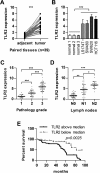The regulation of Toll-like receptor 2 by miR-143 suppresses the invasion and migration of a subset of human colorectal carcinoma cells
- PMID: 23866094
- PMCID: PMC3750391
- DOI: 10.1186/1476-4598-12-77
The regulation of Toll-like receptor 2 by miR-143 suppresses the invasion and migration of a subset of human colorectal carcinoma cells
Abstract
Background: The Toll-like receptor 2 (TLR2)-driven tissue response may promote neoangiogenesis and tumour growth by mechanisms that are poorly understood.
Methods: We investigated the expression levels of TLR2 and associated-miRNAs in colorectal carcinoma (CRC) tissues and cell lines using real-time PCR, northern blotting and western blotting. Survival curver was generated by Log-Rank test and the role of TLR2 signalling in tumour invasion and migration was determined by transwell analysis kits.
Results: We observed that the tissues from CRC patients express relatively high levels of TLR2. Targeting TLR2 markedly reduces the invasion and migration of CRC cells. We also found that miR-143, a putative tumour suppressor that is down-regulated in CRC tissues, reduces the invasion and migration of CRC cells primarily via TLR2. Utilising a xenograft mouse model, we demonstrated that re-expression of miR-143 inhibits CRC cell colonisation in vivo.
Conclusion: miR-143 blocks the TLR2 signalling pathway in human CRC cells. This knowledge may pave the way for new clinical applications utilising miR-143 mimics in the treatment of patients with CRC.
Figures





Similar articles
-
miR-154 suppresses colorectal cancer cell growth and motility by targeting TLR2.Mol Cell Biochem. 2014 Feb;387(1-2):271-7. doi: 10.1007/s11010-013-1892-3. Epub 2013 Nov 16. Mol Cell Biochem. 2014. PMID: 24242044
-
Long non-coding RNA TP73-AS1 sponges miR-194 to promote colorectal cancer cell proliferation, migration and invasion via up-regulating TGFα.Cancer Biomark. 2018;23(1):145-156. doi: 10.3233/CBM-181503. Cancer Biomark. 2018. PMID: 30010111
-
MicroRNA-544a Regulates Migration and Invasion in Colorectal Cancer Cells via Regulation of Homeobox A10.Dig Dis Sci. 2016 Sep;61(9):2535-44. doi: 10.1007/s10620-016-4186-2. Epub 2016 May 10. Dig Dis Sci. 2016. PMID: 27165435
-
miR-532 promotes colorectal cancer invasion and metastasis by targeting NKD1.Cell Mol Biol (Noisy-le-grand). 2019 Jul 31;65(6):52-55. Cell Mol Biol (Noisy-le-grand). 2019. PMID: 31472047
-
Potential genetic biomarker of Saudi Arabian patients with colorectal cancer.Eur Rev Med Pharmacol Sci. 2022 May;26(9):3109-3126. doi: 10.26355/eurrev_202205_28728. Eur Rev Med Pharmacol Sci. 2022. PMID: 35587061 Review.
Cited by
-
MicroRNA-143 sensitizes acute myeloid leukemia cells to cytarabine via targeting ATG7- and ATG2B-dependent autophagy.Aging (Albany NY). 2020 Oct 19;12(20):20111-20126. doi: 10.18632/aging.103614. Epub 2020 Oct 19. Aging (Albany NY). 2020. PMID: 33077697 Free PMC article.
-
Evaluation of Toll-Like Receptor Expression with Clinicopathologic Variables in Endometrium Cancer.Sisli Etfal Hastan Tip Bul. 2018 Sep 4;52(3):196-200. doi: 10.14744/SEMB.2018.63325. eCollection 2018. Sisli Etfal Hastan Tip Bul. 2018. PMID: 32595398 Free PMC article.
-
Circulating miR-141-3p, miR-143-3p and miR-200c-3p are differentially expressed in colorectal cancer and advanced adenomas.Mol Clin Oncol. 2019 Aug;11(2):201-207. doi: 10.3892/mco.2019.1876. Epub 2019 Jun 11. Mol Clin Oncol. 2019. PMID: 31316774 Free PMC article.
-
Toll-Like Receptors and the Response to Radiotherapy in Solid Tumors: Challenges and Opportunities.Vaccines (Basel). 2023 Apr 7;11(4):818. doi: 10.3390/vaccines11040818. Vaccines (Basel). 2023. PMID: 37112730 Free PMC article. Review.
-
Epigenetic Alterations in Colorectal Cancer: Emerging Biomarkers.Gastroenterology. 2015 Oct;149(5):1204-1225.e12. doi: 10.1053/j.gastro.2015.07.011. Epub 2015 Jul 26. Gastroenterology. 2015. PMID: 26216839 Free PMC article. Review.
References
-
- Jemal A, Bray F, Center MM, Ferlay J, Ward E, Forman D. Global cancer statistics. CA Cancer J Clin. 2011;61:69–90. - PubMed
-
- Krieg AM. Therapeutic potential of Toll-like receptor 9 activation. Nat Rev Drug Discov. 2006;5:471–484. - PubMed
-
- Schmidt C. Immune system’s Toll-like receptors have good opportunity for cancer treatment. J Natl Cancer Inst. 2006;98:574–575. - PubMed
-
- Aranda FLD, Diaz-Valdes N, Riezu-Boj JI, Bezunartea J, Ruiz M, Martinez M, Durantez M, Mansilla C, Prieto J, Lasarte JJ, Borras-Cuesta F. et al.Adjuvant Combination and Antigen Targeting as a Strategy to Induce Polyfunctional and High-Avidity T-Cell Responses against Poorly Immunogenic Tumors. Cancer Res. 2011;71:3214–3224. - PubMed
Publication types
MeSH terms
Substances
LinkOut - more resources
Full Text Sources
Other Literature Sources
Medical

